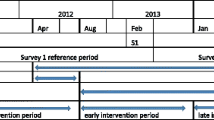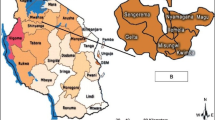Abstract
Objective
We assess how countries in regions of the world where maternal mortality is highest—South Asia and Sub-Saharan Africa—are performing with regards to providing women with vital elements of the continuum of care.
Methods
Using recent Demographic and Health Survey data from nine countries including 18,036 women, descriptive and multilevel regression analyses were conducted on four key elements of the continuum of care—at least one antenatal care visit, four or more antenatal care visits, delivery with a skilled birth attendant and postnatal checks for the mother within the first 24 h since birth. Family planning counseling within a year of birth was also included in the descriptive analyses.
Results
Results indicated that a major drop-out (>50 %) occurs early on in the continuum of care between the first antenatal care visit and four or more antenatal care visits. Few women (<5 %) who do not receive any antenatal care go on to have a skilled delivery or receive postnatal care. Women who receive some or all the elements of the continuum of care have greater autonomy and are richer and more educated than women who receive none of the elements.
Conclusion
Understanding where drop-out occurs and who drops out can enable countries to better target interventions. Four or more ANC visits plays a pivotal role within the continuum of care and warrants more programmatic attention. Strategies to ensure that vital services are available to all women are essential in efforts to improve maternal health.


Similar content being viewed by others
References
Kerber, K., de Graft, J., Bhutta, Z., Okong, P., Starrs, A., & Lawn, J. (2007). Continuum of care for maternal, newborn, and Child health: From slogan to service delivery. The Lancet, 370(9595), 1358–1369.
Wang, W., & Hong, R. (2015). Levels and determinants of continuum of care for maternal and newborn health in Cambodia-evidence from a population-based survey. BMC Pregnancy and Childbirth, 15(1), 62. doi:10.1186/s12884-015-0497-0.
Lawn, J. E., Tinker, A., & Munjanja, S. P. (2006). Where is maternal and child health now? The Lancet, 368(9546), 1474–1477.
Gill, K., Pande, R., & Malhotra, R. (2007). Women deliver for development. The Lancet, 370(9595), 1347–1357.
WHO. (2014). Trends in maternal mortality: 1990 to 2013 estimates by WHO, UNICEF, UNFPA. The World Bank and the United Nations Population Division: WHO.
UNICEF. (2013). Levels and trends in child mortality. Estimates by the UN-Interagency Group for Child Mortality Estimation. New York: UNICEF.
Lawn, J. E., Cousens, S., Zupan, J., & Lancet Neonatal Survival Steering Committee. (2005). 4 Million neonatal deaths: When? Where? Why? The Lancet, 365(9462), 891–900.
Lawn, J. E., Blencowe, H., Pattinson, R., Cousens, S., Kumar, R., Gardosi, J., et al. (2011). Stillbirths: Where? When? Why? How to make the data count? The Lancet, 377(9775), 1448–1463.
Gaffield, M. E., Egan, S., & Temmerman, M. (2014). It’s about time: WHO and partners release programming strategies for postpartum family planning. Global Health: Science and Practice, 2(1), 4–9.
Cleland, J., Conde-Agudelo, A., Peterson, H., Ross, J., & Tsui, A. (2012). Contraception and health. The Lancet, 380(9837), 149–156.
WHO. (2014). Recommendations on the care of the newborn. Geneva: WHO.
UNICEF. State of the World’s Children. (2014). Cited August 22, 2014. http://www.unicef.org/sowc2014/numbers/.
ICF International. (2012). 2004–2012. Demographic and Health Surveys (various) [Datasets]. Calverton, Maryland: ICF International [Distributor]
Rabe-Hesketh, S., & Skrondal, A. (2012). A multilevel and longitudinal modeling using stata (3rd ed.). College Station: Stata Press.
Stanton, C., Blanc, A., Croft, T., & Choi, Y. (2007). Skilled care at birth in the developing world: Progress to date and strategies for expanding coverage. Journal of Biosocial Science, 39(1), 109–120.
Ensor, T., Quigley, P., Green, C., Badru, A. R., Kaluba, D., & Siziya, S. (2013). Knowledgeable antenatal care as a pathway to skilled delivery: Modelling the interactions between use of services and knowledge in Zambia. Health Policy and Planning,. doi:10.1093/heapol/czt044.
Guliani, H., Sepehri, A., & Serieux, J. (2012). What impact does contact with the prenatal care system have on women’s use of facility delivery? Evidence from low-income countries. Social Science and Medicine, 74(12), 1882–1890.
Adiwanou, V., & LeGrand, T. (2013). Does antenatal care matter in the use of skilled birth attendance in rural Africa: A multi-country analysis. Social Science and Medicine, 2013(86), 26–34.
Magoma, M., Requejo, J., Campbell, O., Cousens, S., Merialdi, M., & Filippi, V. (2013). The effectiveness of birth plans in increasing use of skilled care at delivery and postnatal care in rural Tanzania: A cluster randomised trial. Tropical Medicine & International Health, 18(4), 435–443.
Rai, R. K. (2014). Tracking women and children in a continuum of reproductive, maternal, newborn, and child healthcare (RMNCH) in India. Journal of Epidemiology and Global Health, 4(3), 239–243.
Osaki, K., Hattori, T., & Kosen, S. (2013). The role of home-based records in the establishment of a continuum of care for mothers, newborns, and children in Indonesia. Global Health Action, 6(1), 1–12.
Lund, S., Nielsen, B. B., Hemed, M., Boas, I. M., Said, A., Said, K., et al. (2014). Mobile phones improve antenatal care attendance in Zanzibar: A cluster randomized controlled trial. BMC Pregnancy and Childbirth, 14(1), 29. doi:10.1186/1471-2393-14-29.
Lim, S., Dandona, L., Hoisington, J. A., James, S., Hogan, M., & Gakidou, E. (2010). India’s Janani Suraksha Yojana, a conditional cash transfer programme to increase births in health facilities; an impact evaluation. The Lancet, 375(9730), 2009–2023.
Glassman, A., Duran, D., Fleisher, L., Singer, D., Sturke, R., & Angeles, G. (2013). Impact of conditional cash transfers on maternal and newborn health. Journal of Health Population and Nutrition, 4(Suppl 2), S48–S66.
World Health Organization (WHO), United Nations Children’s Fund (UNICEF). (2009). Home visits for the newborn child: A strategy to improve survival. Geneva: WHO.
Gupta, S., Yamada, G., Mpembeni, R., Frumence, G., Callaghan-Koru, J. A., Stevenson, R., et al. (2014). Factors associated with four or more antenatal care visits and its decline among pregnant women in Tanzania between 1999 and 2010. PLoS One, 9(7), e101893.
Mathole, T., Lindmark, G., Majoko, F., & Ahlberg, B. M. (2004). A qualitative study of women’s perspectives of antenatal care in a rural area of Zimbabwe. Midwifery, 20(2), 122–132.
Singh, K., Bloom, S., Haney, E., Olorunsaiye, C., & Brodish, P. (2012). Gender equality and childbirth in a health facility: Nigeria and MDG5. African Journal of Reproductive Health, 16(3), 123–129.
Fotso, J. C., Ezeh, A. C., & Essendi, H. (2009). Maternal health in resource-poor urban settings: How does women’s autonomy influence the utilization of obstetric care services. Reproductive Health, 6(9), 1–8. doi:10.1186/1742-4755-6-9.
Bloom, S. S., Wypij, D., & Das Gupta, M. (2001). Dimensions of women’s autonomy and the influence on maternal health care utilization in a North Indian city. Demography, 38(1), 67–78.
USAID. (2015). Ending preventable maternal mortality: USAID maternal health vision for action. Evidence for strategic approaches. Washington: USAID.
WHO. (2015). Recommendations on health promotion interventions for maternal and newborn health. Geneva: WHO.
Hodgins, S., & D’Agostino, A. (2014). The quality-coverage gap in antenatal care: Towards better measurement of effective coverage. Global Health Science and Practice, 2(2), 173–181.
Acknowledgments
This study was funded by the United States Agency for International Development (USAID) through a cooperative agreement (GHA-A-00-08-00003-00) with MEASURE Evaluation. The views expressed in this paper do not necessarily reflect those of USAID. This work was also supported in part by an R24 Center Grant (R24 HD050924) and a T32 Training Grant (T32 HD007168) to the Carolina Population Center at the University of North Carolina at Chapel Hill.
Author information
Authors and Affiliations
Corresponding author
Rights and permissions
About this article
Cite this article
Singh, K., Story, W.T. & Moran, A.C. Assessing the Continuum of Care Pathway for Maternal Health in South Asia and Sub-Saharan Africa. Matern Child Health J 20, 281–289 (2016). https://doi.org/10.1007/s10995-015-1827-6
Published:
Issue Date:
DOI: https://doi.org/10.1007/s10995-015-1827-6




